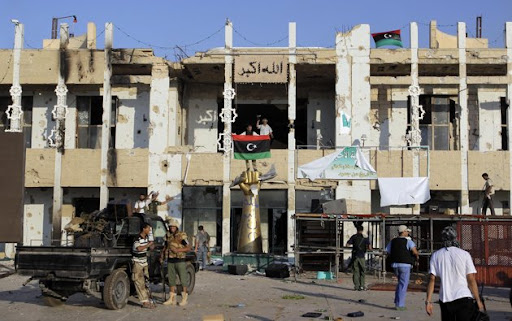 BENEATH the grassy courtyard of Muammar Gaddafi's compound, long tunnels connect bunkers, command centres and spiral staircases that lead to a luxurious home.
BENEATH the grassy courtyard of Muammar Gaddafi's compound, long tunnels connect bunkers, command centres and spiral staircases that lead to a luxurious home.
When rebels took over the Tripoli compound on Wednesday, they discovered this long-rumoured underground network.
Outsiders had never seen the tunnels beneath the Bab al-Aziziya compound. Many Libyans assume the passages connect all of Tripoli --which they say explains Gaddafi's ability to appear for speeches in places where no one saw him arrive.
Some guess he fled the city through the tunnels, although because of damage from NATO bombing, it was impossible to determine whether the tunnels extend outside of Bab al-Aziziya.
The compound had always been a mystery to most Libyans. Although it is one of the city's largest landmarks, no streets signs indicate where it is.
Few ever entered, and many Tripoli residents refused to walk nearby, fearing guards on the compound's high green walls would arrest or shoot them.
"There's a Tripoli above ground and a Tripoli underground," said rebel fighter Ismail Dola, 26, exploring the tunnels with friends.
The tunnels are high enough for a tall person to stand upright and wide enough so two people can walk comfortably abreast.
Their walls are 30cm-thick concrete, with heavy metal doors dividing tunnels into sections.
Gas masks are placed throughout the complex, along with water, cola, biscuits and tuna. Refrigerators stand in corners.
The tunnels lead to an array of rooms. Some are sleeping quarters with double beds, small refrigerators and dressers, perhaps meant for guards. Others appear to be blast bunkers, with thicker walls and small metal hatches.
In one tunnel lies the ruins of a smashed white and green golf cart -- the kind Gaddafi often drove.
In places, the tunnels open into multi-room complexes. One lies under Gaddafi's former residence.
Doors at the top of curving, tiled stairways to the house have been bricked shut. Nearby is a broken lift.
One area on the compound's edge, reduced to rubble by NATO bombs, has rooms full of TVs and at least three escape ramps leading to the street.
Another section has bunk beds, a full sitting room, a bathroom, kitchen and an office full of video production equipment.
Brazilian plastic surgeon Liacyr Ribeiro, who operated on Gaddafi for under-eye bags, recounted his rare visit to the bunker. Dr Ribeiro, 70, was at a medical conference in Tripoli in 1994 when Libya's then health minister asked him to "examine someone dear to me".
"I thought it was his wife," he said from Rio De Janeiro. "When we arrived, I realised it was Gaddafi. The entrance of the bunker was a zigzag shape, and they made me wait in the library."
Then they lead Dr Ribeiro to a building "where there was a tent".
"It was there that Gaddafi greeted me," he said. "I told him it was too dark to examine him there, and he took me into a very modern dental office. It was amazing. I did not at all expect to see such a thing," he added of the bunker, where he said there was a gym with an Olympic-sized pool, which had yet to be found.
"At the time Gaddafi was in very good physical form," said Dr Ribeiro, adding that he returned in 1995 to perform a hair implant.

 10:04
10:04
 Reportage
Reportage

 Posted in:
Posted in: 





0 comments:
Post a Comment